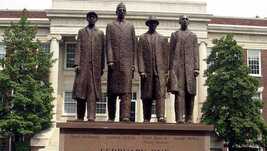 North Carolina State Senator John D. Bellamy Jr., 1891. North Carolina State Senator John D. Bellamy Jr., 1891. In 1891, the North Carolina General Assembly founded the College of Agriculture and Mechanic Arts for Colored Students in Greensboro. This was the first university in North Carolina that offered higher learning for students of color. This first step in inclusivity and diversity in North Carolina’s public education system was not one the state’s elected officials made easily or altruistically, and it took the support of one of the Bellamy children to make it a reality. In 1890, John D. Bellamy Jr., third son of John D. and Eliza Bellamy, was elected to represent New Hanover County in the North Carolina Senate. While he never ran on a campaign for higher education for Black North Carolinians, his lasting legislative legacy was his involvement in just that. In 1879, James O’Hara-- a former state Representative of Halifax County who would go on to be elected second Black U.S. Congressman from North Carolina-- spearheaded the first attempt to establish a Black college in North Carolina. In a speech reported by The Journal of Industry, O’Hara called on the legislators of North Carolina to create and foster an environment for the education of Black students equal to the state university at Chapel Hill--known today as University of North Carolina at Chapel Hill. That same year, John A. White, another Black legislator from Halifax County, attempted to pass a bill for the creation of a Black university. The bill quickly died due to White supremacist ideals and lack of support for Black education in the state legislature, but state-wide support for a segregated university grew among Black and White North Carolinians alike, for differing reasons, as to avoid integration of Black and White students. In 1886, a Black state teachers’ association demanded that people of color be admitted to the University of North Carolina at Chapel Hill. This caused anti-Black sentiments to skyrocket in North Carolina. Former slave holders did not want their former enslaved workers and descendants to be in school with their own children and grandchildren. Despite the rise in White supremacist and anti-Black sentiments, Henry Eppes, another Black senator from Halifax County, proposed a bill for a college for Black citizens of North Carolina in 1887. He asked for $10,000 in funding the first year and $1,000 annually thereafter. It was rejected 37-1. In 1889, there were two additional attempts by Black legislators to pass a bill creating an agricultural and mechanical college for Black North Carolinians, yet they both failed as well. It was not until the U.S. Congress passed the second Morrill Act in 1890 that White members of North Carolina’s General Assembly began to take seriously the notion of establishing a university for Black students. The first Morrill Act of 1862, set aside federal lands to create colleges to “benefit agricultural and mechanical arts.” It gave each state 30,000 acres of land to be distributed by state senators and representatives. This act was directly responsible for the North Carolina College of Agriculture and Mechanic Arts-- known today as North Carolina State University. With the passing of the second Morrill Act, the U.S. Congress prevented federal dollars being distributed to states that did not have integrated institutions of higher education or at least a separate college for Black students. The 1890 Morrill Act allocated $15,000 to each state, which increased yearly by $1,000 for 10 years until it reached a maximum of $25,000 per annum. One stipulation was that the annual appropriations had to be divided equally between Black and White schools in states that maintained segregated universities. In 1890, Secretary of the Interior John W. Noble sent letters to North Carolina Governor Daniel G. Fowle asking three questions pertaining to agricultural colleges in North Carolina: Are there agricultural and mechanical colleges in North Carolina? If so, are they segregated? And if they are segregated, are there colleges for both White and Black students? Governor Fowle responded saying there was a university-- North Carolina State University—but it was segregated, and there was no equitable university for Black students. Secretary Noble then notified Governor Fowle that since there was no college for Black students, North Carolina did not qualify for the funding established in the Morrill Acts. Governor Fowle then notified the state legislature that for this reason, and this reason only, North Carolina needed to establish a Black agricultural and mechanical college.  North Carolina legislator Isaac Alston. North Carolina legislator Isaac Alston. On January 9, 1891, Isaac Alston, a Black legislator representing the 19th District of Warren County, introduced SB12 which would establish a Black college in North Carolina, but it was promptly denied. On March 5, 1891, John D. Bellamy Jr. sponsored SB12, where it easily passed its first, second, and third readings and was ordered enrolled by the House of Representatives the following day, March 6th. So why did the General Assembly deny all previously sponsored or introduced bills? A likely contributing factor was that every representative who had-- O’Hara, White, Alston-- were Black. John D. Bellamy Jr. was White. The Morrill Act of 1890 also backed North Carolina into a corner: either establish a Black college or lose all federal funding for the colleges already established. The state Senate had not wanted to support higher education for Black students, evidenced by their refusal to pass previous bills for Black universities proposed by Black Senators, but the idea of losing all federal funding for UNC-CH and NC State caused a swift about-face. On March 9, 1891, the North Carolina General Assembly founded the Agricultural and Mechanical College for the Colored Race—now known as A&T University. Since its founding, A&T University has been recognized as a premier university in North Carolina. The university’s second president, James B. Dudley, was from Wilmington. John Jr. bragged Dudley’s appointment by the General Assembly was a “compliment” to himself. In 1928, the university opened its’ doors to female students. And in 1945, then First Lady Eleanor Roosevelt visited the campus. A&T University has won seven HBCU football national championships, and notable alumni include Rev. Jesse Jackson, astronaut Ronald McNair, and United States Army Nurse Corps Clara Leach Adams-Ender. The university eventually played an important an role in the American Civil Rights Movement, and Greensboro became nationally known for both peaceful protests and violent clashes. On February 1, 1960, four A&T students: Ezell Blair, Joseph McNeil, Franklin McCain, and David Richmond sat-in at Woolworth’s in Greensboro, an all-White restaurant, beginning the nationally known Greensboro sit-ins that lasted until July of 1960 and spread to many other segregated cities in the South. In 1969, the university was involved in the 1969 Greensboro Uprising, wherein the National Guard infiltrated the university after mass protests erupted over a student body election at the nearby all-Black James B. Dudley High School. The event has been described as “the most massive armed assault ever made against an American university” which left two A&T students dead and eighteen injured. Bellamy likely could never have imagined how prestigious the university would become nor the impact A&T would make on the Civil Rights Movement as a whole though he remained proud of his part in founding the university until his death. In John Jr.’s 1942 autobiography, Memoirs of an Octogenarian, which he wrote during his last year of life, he boasted that, “many other bills...were passed” during his time in the General Assembly, but he only went into detail about his role in establishing A&T University explaining he “drafted the charter for the Negro Agricultural College at Greensboro.” John Jr. never explicitly stated why he suddenly supported SB12; if he was taking it on because he truly believed in a need for a Black college or if he was simply supporting it to secure federal funding for other colleges, but it is most likely at the intersection of myriad reasons he chose to support SB12. Regardless his motivations, the outcome is that A&T University is celebrating 130 years as North Carolina’s first institution for higher education for Black students, and we at the Bellamy Museum say, “Go Aggies!!” This blog post is the product of current and ongoing research into John Jr.’s early political career.
Written by Taylor Klauk (UNCW Anthropology and History Intern) Sources: Act of July 2, 1862 (Morrill Act), Public Law 37-108, which established land grant colleges, 07/02/1862; Enrolled Acts and Resolutions of Congress, 1789-1996; Record Group 11; General Records of the United States Government; National Archives “Journal of the Senate of the General Assembly of the State of North Carolina at its session of 1891.” North Carolina Senate Minutes, The Senate, 1891. Lee, J.M. and Keys, S.W. (2013). Land-grant But Unequal: State One-to -One Match Funding for 1890 Land-grant Universities. (APLU Office of Access and Success publication no. 3000-PB1). Washington, DC: Association of Public and Land-grant Universities. Logan, Frenise. “Legislation Provided Key for A&T History.” News & Record (Greensboro, NC), Jan. 12, 1991. “North Carolina A&T State University.” Wikipedia. Wikimedia Foundation, September 4, 2021. https://en.wikipedia.org/wiki/North_Carolina_A%26T_State_University#Civil_Rights_Movement. pg. 103 of "Memoirs of an Octogenarian" https://digital.lib.ecu.edu/17041
3 Comments
2/16/2022 04:13:20 pm
If so, are they segregated? And if they are segregated, are there colleges for both White and Black students? Thank you for the beautiful post!
Reply
Leslie Morton--Operations Mgr.
2/16/2022 04:17:42 pm
A&T was founded by the General Assembly as a segregated college, and though it remains an HBCU, it is integrated. All institutions of higher education in the state are integrated.
Reply
1/24/2024 09:39:01 am
Reply
Leave a Reply. |
Older Blog Posts
To see all previous blog posts, please click here. Blogs written after summer 2020 will be found on this page. AuthorOur blogs are written by college interns, staff, and Bellamy volunteers. Archives
July 2024
Categories |
|
Ticket Sales
10:00 am - 4:00 pm daily
Monday-Friday 9:30 am- 5 pm |
Admission Prices (tax not reflected)
Self-guided
|







 RSS Feed
RSS Feed




